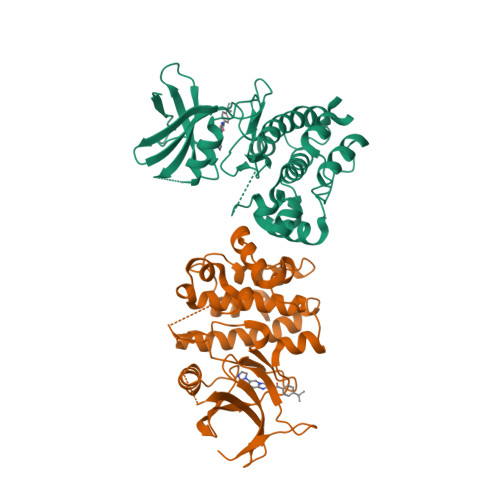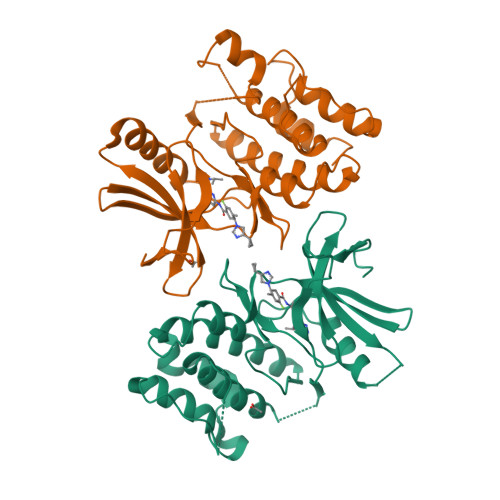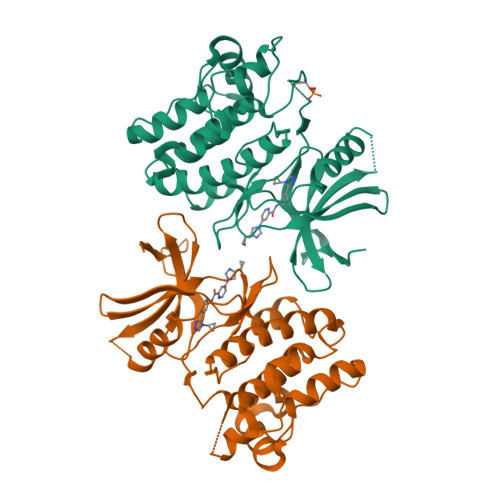
Top ▲

GtoPdb is requesting financial support from commercial users. Please see our sustainability page for more information.
 target has curated data in GtoImmuPdb
target has curated data in GtoImmuPdb
Target id: 2080
Nomenclature: mitogen-activated protein kinase kinase kinase 5
Abbreviated Name: ASK1
Family: STE11 family
Gene and Protein Information  |
||||||
| Species | TM | AA | Chromosomal Location | Gene Symbol | Gene Name | Reference |
| Human | - | 1374 | 6q23.3 | MAP3K5 | mitogen-activated protein kinase kinase kinase 5 | |
| Mouse | - | 1380 | 10 A3 | Map3k5 | mitogen-activated protein kinase kinase kinase 5 | |
| Rat | - | - | 1p 12 | Map3k5 | mitogen-activated protein kinase kinase kinase 5 | |
Previous and Unofficial Names  |
| apoptosis signal regulating kinase 1 | ASK1 | MAPK/ERK kinase kinase 5 | MAPKKK5 | MEK kinase 5 |
Database Links  |
|
| Alphafold | Q99683 (Hs), O35099 (Mm) |
| BRENDA | 2.7.11.25 |
| ChEMBL Target | CHEMBL5285 (Hs), CHEMBL4879411 (Mm) |
| Ensembl Gene | ENSG00000197442 (Hs), ENSMUSG00000071369 (Mm), ENSRNOG00000031700 (Rn) |
| Entrez Gene | 4217 (Hs), 26408 (Mm), 293015 (Rn) |
| Human Protein Atlas | ENSG00000197442 (Hs) |
| KEGG Enzyme | 2.7.11.25 |
| KEGG Gene | hsa:4217 (Hs), mmu:26408 (Mm), rno:293015 (Rn) |
| OMIM | 602448 (Hs) |
| Pharos | Q99683 (Hs) |
| RefSeq Nucleotide | NM_005923 (Hs), NM_008580 (Mm) |
| RefSeq Protein | NP_005914 (Hs), NP_032606 (Mm) |
| SynPHARM | 81444 (in complex with compound 10 [PMID: 23147077]) |
| UniProtKB | Q99683 (Hs), O35099 (Mm) |
| Wikipedia | MAP3K5 (Hs) |
Selected 3D Structures  |
|||||||||||||

|
|
||||||||||||

|
|
||||||||||||

|
|
||||||||||||

|
|
||||||||||||
Enzyme Reaction  |
||||
|
||||
Download all structure-activity data for this target as a CSV file 
| Inhibitors | |||||||||||||||||||||||||||||||||||||||||||||||||||||||||||||||||||||||||||||||||||||||||||||||||||||||||||||||||||||||||||||||||||||||||||||||||||||||||||||||||||||||||||||||||||
| Key to terms and symbols | View all chemical structures | Click column headers to sort | |||||||||||||||||||||||||||||||||||||||||||||||||||||||||||||||||||||||||||||||||||||||||||||||||||||||||||||||||||||||||||||||||||||||||||||||||||||||||||||||||||||||||||||||||
|
|||||||||||||||||||||||||||||||||||||||||||||||||||||||||||||||||||||||||||||||||||||||||||||||||||||||||||||||||||||||||||||||||||||||||||||||||||||||||||||||||||||||||||||||||||
| Inhibitor Comments | |||||||||||||||||||||||||||||||||||||||||||||||||||||||||||||||||||||||||||||||||||||||||||||||||||||||||||||||||||||||||||||||||||||||||||||||||||||||||||||||||||||||||||||||||||
| GS-444217 exhibits >50-fold greater affinity for ASK1 compared with all other kinases tested [23]. | |||||||||||||||||||||||||||||||||||||||||||||||||||||||||||||||||||||||||||||||||||||||||||||||||||||||||||||||||||||||||||||||||||||||||||||||||||||||||||||||||||||||||||||||||||
DiscoveRx KINOMEscan® screen  |
|||||||||||||||||||||||||||||||||||||||||||||||||||||||||||||||||||||||||||||||||||||||||||||||||||||||||||||||||||||||||||||||||||||||||||||||||||||||||||||||||||||||
|
A screen of 72 inhibitors against 456 human kinases. Quantitative data were derived using DiscoveRx KINOMEscan® platform. http://www.discoverx.com/services/drug-discovery-development-services/kinase-profiling/kinomescan Reference: 5,25 |
 
|
||||||||||||||||||||||||||||||||||||||||||||||||||||||||||||||||||||||||||||||||||||||||||||||||||||||||||||||||||||||||||||||||||||||||||||||||||||||||||||||||||||||
| Key to terms and symbols | Click column headers to sort | ||||||||||||||||||||||||||||||||||||||||||||||||||||||||||||||||||||||||||||||||||||||||||||||||||||||||||||||||||||||||||||||||||||||||||||||||||||||||||||||||||||||
| Target used in screen: ASK1 | |||||||||||||||||||||||||||||||||||||||||||||||||||||||||||||||||||||||||||||||||||||||||||||||||||||||||||||||||||||||||||||||||||||||||||||||||||||||||||||||||||||||
|---|---|---|---|---|---|---|---|---|---|---|---|---|---|---|---|---|---|---|---|---|---|---|---|---|---|---|---|---|---|---|---|---|---|---|---|---|---|---|---|---|---|---|---|---|---|---|---|---|---|---|---|---|---|---|---|---|---|---|---|---|---|---|---|---|---|---|---|---|---|---|---|---|---|---|---|---|---|---|---|---|---|---|---|---|---|---|---|---|---|---|---|---|---|---|---|---|---|---|---|---|---|---|---|---|---|---|---|---|---|---|---|---|---|---|---|---|---|---|---|---|---|---|---|---|---|---|---|---|---|---|---|---|---|---|---|---|---|---|---|---|---|---|---|---|---|---|---|---|---|---|---|---|---|---|---|---|---|---|---|---|---|---|---|---|---|---|---|
|
|||||||||||||||||||||||||||||||||||||||||||||||||||||||||||||||||||||||||||||||||||||||||||||||||||||||||||||||||||||||||||||||||||||||||||||||||||||||||||||||||||||||
| Displaying the top 10 most potent ligands View all ligands in screen » | |||||||||||||||||||||||||||||||||||||||||||||||||||||||||||||||||||||||||||||||||||||||||||||||||||||||||||||||||||||||||||||||||||||||||||||||||||||||||||||||||||||||
EMD Millipore KinaseProfilerTM screen/Reaction Biology Kinase HotspotSM screen  |
||||||||||||||||||||||||||||||||||||||||||||||||||||||||||||||||||||||||||||||||||||||||||||||||||||||||||||||||||||||||||||||||||||||||||||||||||||||||||||||||||||||||
|
A screen profiling 158 kinase inhibitors (Calbiochem Protein Kinase Inhibitor Library I and II, catalogue numbers 539744 and 539745) for their inhibitory activity at 1µM and 10µM against 234 human recombinant kinases using the EMD Millipore KinaseProfilerTM service. A screen profiling the inhibitory activity of 178 commercially available kinase inhibitors at 0.5µM against a panel of 300 recombinant protein kinases using the Reaction Biology Corporation Kinase HotspotSM platform. http://www.millipore.com/techpublications/tech1/pf3036 http://www.reactionbiology.com/webapps/main/pages/kinase.aspx Reference: 1,7 |

|
|||||||||||||||||||||||||||||||||||||||||||||||||||||||||||||||||||||||||||||||||||||||||||||||||||||||||||||||||||||||||||||||||||||||||||||||||||||||||||||||||||||||
| Key to terms and symbols | Click column headers to sort | |||||||||||||||||||||||||||||||||||||||||||||||||||||||||||||||||||||||||||||||||||||||||||||||||||||||||||||||||||||||||||||||||||||||||||||||||||||||||||||||||||||||
| Target used in screen: ASK1/ASK1(MAP3K5) | ||||||||||||||||||||||||||||||||||||||||||||||||||||||||||||||||||||||||||||||||||||||||||||||||||||||||||||||||||||||||||||||||||||||||||||||||||||||||||||||||||||||||
|---|---|---|---|---|---|---|---|---|---|---|---|---|---|---|---|---|---|---|---|---|---|---|---|---|---|---|---|---|---|---|---|---|---|---|---|---|---|---|---|---|---|---|---|---|---|---|---|---|---|---|---|---|---|---|---|---|---|---|---|---|---|---|---|---|---|---|---|---|---|---|---|---|---|---|---|---|---|---|---|---|---|---|---|---|---|---|---|---|---|---|---|---|---|---|---|---|---|---|---|---|---|---|---|---|---|---|---|---|---|---|---|---|---|---|---|---|---|---|---|---|---|---|---|---|---|---|---|---|---|---|---|---|---|---|---|---|---|---|---|---|---|---|---|---|---|---|---|---|---|---|---|---|---|---|---|---|---|---|---|---|---|---|---|---|---|---|---|---|
|
||||||||||||||||||||||||||||||||||||||||||||||||||||||||||||||||||||||||||||||||||||||||||||||||||||||||||||||||||||||||||||||||||||||||||||||||||||||||||||||||||||||||
| Displaying the top 10 most potent ligands View all ligands in screen » | ||||||||||||||||||||||||||||||||||||||||||||||||||||||||||||||||||||||||||||||||||||||||||||||||||||||||||||||||||||||||||||||||||||||||||||||||||||||||||||||||||||||||
| Immunopharmacology Comments |
| ASK1 is included in the GToImmuPdb as it is a molecular target for anti-fibrotic drug development. This kinase acts upstream of p38 MAPK and JNK kinases [12], and its activation can drive pulmonary and cardiac fibrotic processes [2,13]. The ASK1>JNK/p38 pathway is also implicated in renal [8,20,23] and liver fibrosis. The most advanced ASK1 inhibitor in clinical development (in January 2020) is Gilead's selonsertib [16], which has been evaluated in patients with nonalcoholic steatohepatitis (NASH) and nonalcoholic fatty liver disease (NAFLD). Selonsertib has completed Phase 3 trials as monotherapy, and is also being tested in combination with antisteatotic/antilipemic agents such as firsocostat (allosteric ACC inhibitor), cilofexor (FXR agonist), fenofibrate (PPARα agonist) and icosapent (in Phase 2 trial NCT02781584). |
| Immuno Process Associations | ||||||||||||
|
||||||||||||
|
||||||||||||
Physiological Consequences of Altering Gene Expression 
|
||||||||||
|
| General Comments |
| Apoptosis signal-regulating kinase 1 (ASK1, MAP3K5) is a stress-activated kinase. It is activated by cytotoxic stress factors such as TNF, Fas and reactive oxygen species (ROS), and once activated (autophosphorylated) it phosphorylates and activates downstream JNK and p38 MAP kinases which are responsible for the inflammatory and apoptotic stress responses [24]. ASK1 is an anti-fibrosis/anti-inflammatory drug target [6,17,20-21]. Modulation of ASK1 activity might also be relevant in the treatment of degenerative neurological disorders (MND [18], MS [9], Parkinson's disease [14], Alzheimer's disease [10] and ischemic stroke [4]) [11]. |
1. Anastassiadis T, Deacon SW, Devarajan K, Ma H, Peterson JR. (2011) Comprehensive assay of kinase catalytic activity reveals features of kinase inhibitor selectivity. Nat Biotechnol, 29 (11): 1039-45. [PMID:22037377]
2. Budas GR, Boehm M, Kojonazarov B, Viswanathan G, Tian X, Veeroju S, Novoyatleva T, Grimminger F, Hinojosa-Kirschenbaum F, Ghofrani HA et al.. (2018) ASK1 Inhibition Halts Disease Progression in Preclinical Models of Pulmonary Arterial Hypertension. Am J Respir Crit Care Med, 197 (3): 373-385. [PMID:28910144]
3. Bunkoczi G, Salah E, Filippakopoulos P, Fedorov O, Müller S, Sobott F, Parker SA, Zhang H, Min W, Turk BE et al.. (2007) Structural and functional characterization of the human protein kinase ASK1. Structure, 15 (10): 1215-26. [PMID:17937911]
4. Cheon SY, Kim EJ, Kim SY, Kim JM, Kam EH, Park JK, Koo BN. (2018) Apoptosis Signal-regulating Kinase 1 Silencing on Astroglial Inflammasomes in an Experimental Model of Ischemic Stroke. Neuroscience, 390: 218-230. [PMID:30172704]
5. Davis MI, Hunt JP, Herrgard S, Ciceri P, Wodicka LM, Pallares G, Hocker M, Treiber DK, Zarrinkar PP. (2011) Comprehensive analysis of kinase inhibitor selectivity. Nat Biotechnol, 29 (11): 1046-51. [PMID:22037378]
6. Furuichi K, Wada T, Iwata Y, Sakai N, Yoshimoto K, Kobayashi Ki K, Mukaida N, Matsushima K, Yokoyama H. (2002) Administration of FR167653, a new anti-inflammatory compound, prevents renal ischaemia/reperfusion injury in mice. Nephrol Dial Transplant, 17 (3): 399-407. [PMID:11865084]
7. Gao Y, Davies SP, Augustin M, Woodward A, Patel UA, Kovelman R, Harvey KJ. (2013) A broad activity screen in support of a chemogenomic map for kinase signalling research and drug discovery. Biochem J, 451 (2): 313-28. [PMID:23398362]
8. Grynberg K, Ma FY, Nikolic-Paterson DJ. (2017) The JNK Signaling Pathway in Renal Fibrosis. Front Physiol, 8: 829. [PMID:29114233]
9. Guo X, Harada C, Namekata K, Matsuzawa A, Camps M, Ji H, Swinnen D, Jorand-Lebrun C, Muzerelle M, Vitte PA et al.. (2010) Regulation of the severity of neuroinflammation and demyelination by TLR-ASK1-p38 pathway. EMBO Mol Med, 2 (12): 504-15. [PMID:21064192]
10. Hasegawa Y, Toyama K, Uekawa K, Ichijo H, Kim-Mitsuyama S. (2018) Role of ASK1/p38 Cascade in a Mouse Model of Alzheimer's Disease and Brain Aging. J Alzheimers Dis, 61 (1): 259-263. [PMID:29154282]
11. Himmelbauer MK, Xin Z, Jones JH, Enyedy I, King K, Marcotte DJ, Murugan P, Santoro JC, Hesson T, Spilker K et al.. (2019) Rational Design and Optimization of a Novel Class of Macrocyclic Apoptosis Signal-Regulating Kinase 1 Inhibitors. J Med Chem, 62 (23): 10740-10756. [PMID:31710475]
12. Ichijo H, Nishida E, Irie K, ten Dijke P, Saitoh M, Moriguchi T, Takagi M, Matsumoto K, Miyazono K, Gotoh Y. (1997) Induction of apoptosis by ASK1, a mammalian MAPKKK that activates SAPK/JNK and p38 signaling pathways. Science, 275 (5296): 90-4. [PMID:8974401]
13. Lanier M, Pickens J, Bigi SV, Bradshaw-Pierce EL, Chambers A, Cheruvallath ZS, Cole D, Dougan DR, Ermolieff J, Gibson T et al.. (2017) Structure-Based Design of ASK1 Inhibitors as Potential Agents for Heart Failure. ACS Med Chem Lett, 8 (3): 316-320. [PMID:28337323]
14. Lee KW, Woo JM, Im JY, Park ES, He L, Ichijo H, Junn E, Mouradian MM. (2015) Apoptosis signal-regulating kinase 1 modulates the phenotype of α-synuclein transgenic mice. Neurobiol Aging, 36 (1): 519-26. [PMID:25219466]
15. Liles JT, Corkey BK, Notte GT, Budas GR, Lansdon EB, Hinojosa-Kirschenbaum F, Badal SS, Lee M, Schultz BE, Wise S et al.. (2018) ASK1 contributes to fibrosis and dysfunction in models of kidney disease. J Clin Invest, 128 (10): 4485-4500. [PMID:30024858]
16. Loomba R, Lawitz E, Mantry PS, Jayakumar S, Caldwell SH, Arnold H, Diehl AM, Djedjos CS, Han L, Myers RP et al.. (2018) The ASK1 inhibitor selonsertib in patients with nonalcoholic steatohepatitis: A randomized, phase 2 trial. Hepatology, 67 (2): 549-559. [PMID:28892558]
17. Ma FY, Tesch GH, Nikolic-Paterson DJ. (2014) ASK1/p38 signaling in renal tubular epithelial cells promotes renal fibrosis in the mouse obstructed kidney. Am J Physiol Renal Physiol, 307 (11): F1263-73. [PMID:25298527]
18. Nishitoh H, Kadowaki H, Nagai A, Maruyama T, Yokota T, Fukutomi H, Noguchi T, Matsuzawa A, Takeda K, Ichijo H. (2008) ALS-linked mutant SOD1 induces ER stress- and ASK1-dependent motor neuron death by targeting Derlin-1. Genes Dev, 22 (11): 1451-64. [PMID:18519638]
19. Notte G. (2014) Apoptosis signal-regulating kinase inhibitor. Patent number: US8742126 B2. Assignee: Gilead Sciences, Inc.. Priority date: 27/01/2012. Publication date: 03/06/2014.
20. Stambe C, Atkins RC, Tesch GH, Masaki T, Schreiner GF, Nikolic-Paterson DJ. (2004) The role of p38alpha mitogen-activated protein kinase activation in renal fibrosis. J Am Soc Nephrol, 15 (2): 370-9. [PMID:14747383]
21. Terada Y, Inoshita S, Kuwana H, Kobayashi T, Okado T, Ichijo H, Sasaki S. (2007) Important role of apoptosis signal-regulating kinase 1 in ischemic acute kidney injury. Biochem Biophys Res Commun, 364 (4): 1043-9. [PMID:17971303]
22. Terao Y, Suzuki H, Yoshikawa M, Yashiro H, Takekawa S, Fujitani Y, Okada K, Inoue Y, Yamamoto Y, Nakagawa H et al.. (2012) Design and biological evaluation of imidazo[1,2-a]pyridines as novel and potent ASK1 inhibitors. Bioorg Med Chem Lett, 22 (24): 7326-9. [PMID:23147077]
23. Tesch GH, Ma FY, Han Y, Liles JT, Breckenridge DG, Nikolic-Paterson DJ. (2015) ASK1 Inhibitor Halts Progression of Diabetic Nephropathy in Nos3-Deficient Mice. Diabetes, 64 (11): 3903-13. [PMID:26180085]
24. Tobiume K, Matsuzawa A, Takahashi T, Nishitoh H, Morita K, Takeda K, Minowa O, Miyazono K, Noda T, Ichijo H. (2001) ASK1 is required for sustained activations of JNK/p38 MAP kinases and apoptosis. EMBO Rep, 2 (3): 222-8. [PMID:11266364]
25. Wodicka LM, Ciceri P, Davis MI, Hunt JP, Floyd M, Salerno S, Hua XH, Ford JM, Armstrong RC, Zarrinkar PP et al.. (2010) Activation state-dependent binding of small molecule kinase inhibitors: structural insights from biochemistry. Chem Biol, 17 (11): 1241-9. [PMID:21095574]
STE11 family: mitogen-activated protein kinase kinase kinase 5. Last modified on 30/01/2020. Accessed on 12/07/2025. IUPHAR/BPS Guide to PHARMACOLOGY, https://www.guidetopharmacology.org/GRAC/ObjectDisplayForward?objectId=2080.